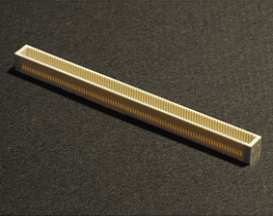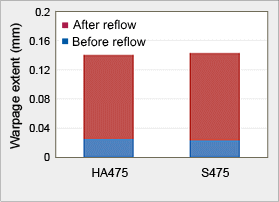Home > Products > LAPEROS(R) LCP
LAPEROS(R) GA/HA Series and Application Development
Introduction |
Liquid crystal polymer (LCP) is a general term for thermoplastic aromatic polyesters that exhibit liquid crystal properties when molten. LCP possesses a rigid molecular structure that is hard to bend and it is characterized by an extremely low level of molecular entanglement, which is normally inherent in polymer substances. Furthermore, LCP exhibits low flow resistance during injection molding and thus high flowability on account of orientation induced by the slightest amount of shear. In addition, the resin boasts high dimensional precision because volume changes due to molecular rearrangement are minimal on account of the structure in the melt phase being retained when the resin solidifies. Due to these properties, demand for LCP is expanding by leaps and bounds amid the trends of more compact and thinner in the electrical and electronic components field. Nowadays, the trend towards more compact and complex electronic components is accelerating and accordingly, the level of requirements in terms of LCP material properties is being raised further. Unlike other polymers, LCP does not derive its name from a particular component or bond. On this account, the degree of freedom in the polymer backbone is high and various types of LCP have been developed in response to specific property requirements. Our company has developed new polymers under the GA HA Series featuring dramatically improved flowability based on our unique polymer design technology accumulated through R&D of LCP, to data and polymerization technology. We plan to deploy these grades in the market moving forward. |
Development of high flow polymer |
LCP exhibits a rapid solidification rate and as such, it is a suitable material for fast cycle molding. Grades with even higher flowability and dimensional stability coupled with low warpage are now required to respond to thinwalling and more complex product shapes in recent years. For high flowability in particular, numerous developments and improvements have been undertaken to date and these have been achieved through (1) reducing molecular weight, (2) blending with low melting point LCP, and (3) optimizing the quantity and size of filler. However, in light of the situation whereby technical limitations are starting to emerge when employing these methods, through research at our company over the course of many years into improving the high flow characteristics of LCP, we discovered the crystallization rate in the mold is an important factor influencing flowability. As indicated in Figure 1, delaying the solidification rate can improve flowability. |
 |
Figure 1: Diagram showing effects of differences in solidification rate on flow length. |
|---|
Figure 2 (a) shows actual differences in flowability in terms of the minimal packing pressure for 0.6-mm pitch connectors molded from GA130 and E130i. The tool used in evaluation is a model tool for the connector shape shown in Figure 2 (b). |
 |
 |
Figure2 (a) : Differences in minimum filling pressure for LAPEROS® E130i and GA130 melt viscosities |
Figure 2 (b) : 0.6-mm pitch connector used in evaluation |
|---|
Comparing filling pressure in our company's connector evaluation tool indicates that for grades with the same level of melt viscosity, E130i and GA130, the filling pressure for the latter can be reduced by about 10%. Because the glass content and average fiber length is of the same order for both E130i and GA130, solidification rate must have brought about the differences in flowability. Control of the LCP solidification rate can be understood via the degree of supercooling (the difference in melting point and crystallization temperature when measured under a specific rate of temperature rise using differential scanning calorimetry (DSC)). The degree of supercooling for these GA and HA polymers is double that of the Ei polymer, and we have succeeded in significantly prolonging the solidification rate. On the other hand, LCP's inherent high heat resistance (SMT (Surface Mount Technology)), mechanical properties, and chemical resistance are retained. Adding these GA/HA polymers to our existing polymer lineup enables us to realize material design that further responds to market needs and applications (Table 1). |
Table 1: Polymer types and properties of GF-reinforced materials |
| Polymer | Features | Melting point (℃) |
Features | ||
| Flexural strength (MPa) |
Flexural modulus (MPa) |
Deflection temperature under load (℃) |
|||
| A | Mechanical strength, structural part applications |
280 | 270 | 15,000 | 240 |
| B | High modulus, high strength |
280 | 300 | 20,000 | 240 |
| C | SMT heat resistance, high strength |
325 | 240 | 14,800 | 255 |
| Ei | Pb-free SMT heat resistance, standard |
340 | 230 | 15,000 | 275 |
| GA | Pb-free SMT heat resistance, high flow |
355 | 200 | 15,000 | 280 |
| HA | Pb-free SMT heat resistance, high flow |
350 | 200 | 15,000 | 280 |
| T | High heat resistance (high melting point) |
370 | 220 | 14,800 | 300 |
| S | Ultra-high heat resistance low outgassing |
355 | 240 | 16,000 | 340 |
* Pb-free: Lead-free solder |
LAPEROS® LCP grade development |
As shown in Table 2, various grades based on LAPEROS® polymer have been developed or are under development that are suitable for use in various electronic components. LCP's properties vary widely in the flow and transverse directions and the resin thus tends to deform on account of this anisotropy. For this reason, materials need to be prepared that match the product shape. Table 3 shows properties of each grade. |
Table 2: Recommended LAPEROS® LCP GA/HA grades for electronic components |
| Connector | CPU socket | I/O, memory | FPC / BtoB | DDR / Card socket |
| Features | Flat surface + mesh | Symmetrical shape | Thin wall | Asymmetrical shape |
| Shape |  |
 |
 |
 |
| Required properties | High strength, |
Low warpage, high strength |
Low warpage, high flow |
Low warpage, low anisotropy |
| Recommended GA/HA grade |
GA130 | GA481 | HA475 | GA481 |
Table 3: LAPEROS® LCP GA/HA grade properties |
GA130 |
GA140M |
GA481 | HA475 | ||
| Grade | >LCP-GF30< | >LCP-GF40< | >LCP-(MD+GF)45< | >LCP-(GF+MD)30< | |
Density |
g/cm3 | 1.61 | 1.70 | 1.77 |
1.64 |
Flexural strength |
MPa | 200 | 155 | 145 | 140 |
Flexural modulus |
MPa | 15,000 | 13,000 | 12,000 | 12,000 |
Flexural strain |
% | 1.8 | 2.5 | 1.7 | 2.5 |
Charpy impact strength (notched) |
kJ/m2 | 20 | 18 | 6 | 6 |
Deflection temperature under load (1.8MPa) |
℃ | 280 | 250 | 265 | 240 |
Deflection temperature under load (0.45MPa) |
℃ | 300 | 270 | - | 275 |
We undertook painstaking grade design using our company's in-house tooling from the perspectives of flowability and warpage in particular. For example, using LAPEROS GA473 for the DDR (Double-Data-Rate Synchronous Dynamic Random Access Memory) -DIMM (Dual Inline Memory Module) socket model shown in Figure 3 (a) achieves an approximately 30% reduction in warpage extent versus an existing grade.Furthermore, filling pressure, which is an indicator for flowability, was reduced by 10-20%. |
 |
 |
Figure 3 (a) DDR connector molded product used for evaluation
|
Figure 3 (b): Extent of warpage in DDR connectors molded from LAPEROS® GA473 and conventional grade. |
|---|
In addition, the FPC (Flexible Printed Circuits) connector shown in Figure 4 (a) is an electronic component that uses LCP material where most advances have been made in downsizing, narrower pitches, lightweighting and thinwalling. The filling pressure for molding of LAPEROS HA475 is roughly 30% lower than that for LAPEROS S475.Moreover, the extent of warpage was around the same as for LAPEROS S475 as indicated in Figure 4 (b). |
 |
 |
Figure 4 (a): FPC connectors used in assessment
|
Figure 4 (b): Extent of warpage in FPC connectors molded from LAPEROS® HA475 and conventional grade |
|---|
On the other hand, solidification rate prolongation control may result in LCP losing its inherent important feature of fast cycle moldability.Figure 5 shows gate seal times for LAPEROS GA130, LAPEROS E130i and DURAFIDE® 1130A6. Gate seal time is defined as the shortest time by which part weight does not vary and is it related to the holding pressure time during injection molding and the molded part weight. Our findings show that gate seal time is much shorter than for DURAFIDE 1130A6 while there is no major different with conventional LCP grades. |
 |
Figure 5: Comparison of gate seal times for LAPEROS® GA130 |
|---|
Conclusions |
The LAPEROS LCP GA/HA Series introduced here are polymers developed under the new concept of "solidification rate control". As introduced at the beginning, the degree of design freedom for LCP's molecular backbone is high, and various types of LCP can be developed depending on the required properties. On the other hand, polymer design technology and expertise cultivated over many years as well as a massive amount of experimentation are required in order to develop polymers with the desired properties. We anticipate that the need for these high flow materials based on these new GA/HA polymers will grow in the field of increasingly smaller and thinner electrical and electronic components. Our company will augment the grade availability of the LAPEROS GA/HA Series in line with market needs moving forward and continue R&D efforts capable of proposing optimum materials on a regular basis. |
* DURAFIDE® and LAPEROS® are registered trademarks of Polyplastics Co., Ltd. in Japan and other countries. |

